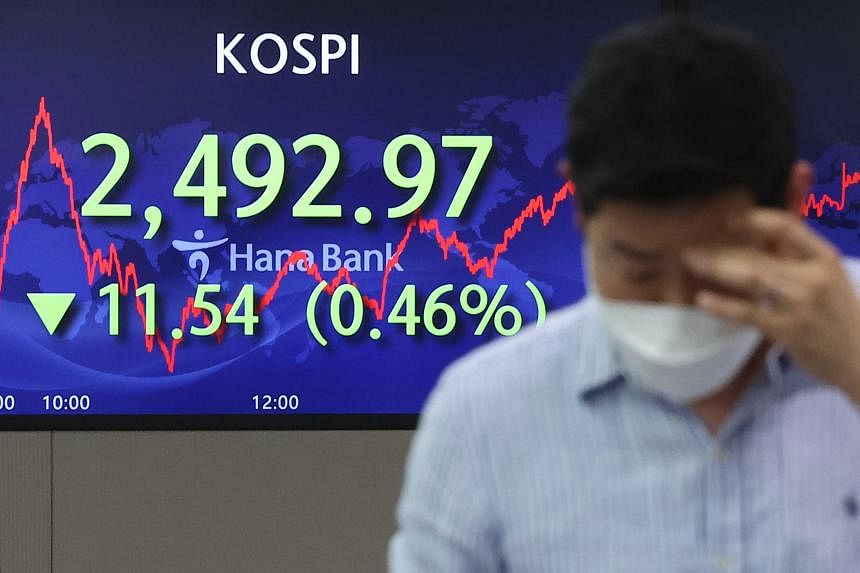SINGAPORE - Soaring inflation, falling US consumer confidence and higher interest rates unleashed the bears on the financial markets this week.
Pandemonium hit Wall Street on Monday (June 13), as its three key indices sank to their lowest levels in six months or more over fears that the Federal Reserve will go with a 75-basis point interest rate hike at its meeting this week to bring under control runaway inflation that has hit 40-year highs.
The S&P500 index tumbled almost 4 per cent to its lowest levels in a year, while the Nasdaq plunged 4.7 per cent amid a selloff of techs - big and small. The Dow Jones index lost over 2.8 per cent.
The fear of a more aggressive rate hike saw US stocks plunge into a bear market on Monday for the first time since March 2020. This refers to when a major stock market index falls 20 per cent or more from a recent high.
“The market was expecting inflation to have peaked but Friday’s data shows that inflation is trending higher and becoming firmly entrenched in inflation expectations,” observed Mr Kelvin Tay, chief investment officer for Asia-Pacific at UBS.
“That caused the bond yields to spike sharply as the concerns are that the Fed will have to hike more than expected to contain inflation.”
The bloodbath on Wall Street had the anticipated impact across Asia on Tuesday (June 14), though most Asian markets recouped some losses by late afternoon amid positive openings in European financial markets.
Across the region, Japan’s Nikkei 225 shed 1.32 per cent, South Korea’s Kospi lost 0.46 per cent, while Australia’s S&P/ASX200 sank 3.55 per cent. Hong Kong’s Hang Seng Index ended almost flat and China’s Shanghai Composite rose 1.02 per cent.
In Singapore, the Straits Times lost 0.97 per cent to end Tuesday's session at a six-month low as banks and blue chips were sold down.
DBS hit a 52-week low, while UOB sank to its lowest levels in six months.
Triggering the risk-off panic, the yield on the two-year US Treasury bond, a benchmark for borrowing costs, briefly rose above the 10-year yield on Monday.
All this is not just shaking up equity markets.
Bond markets are feeling extreme stress, while currency markets are jittery, and the crypto market is in a free fall.
With leading central banks, led by the Fed, aggressively in quantitative tightening mode, there is increasing fear that a recession could hit the global economy by the end of the year.
“Thus far, the Fed has been very firmly behind the curve and even when they had the chance to be aggressive in their rate hikes, they chose to be dovish,” said Mr Tay. “Now they’re paying the price as consumer inflation expectations are entrenched and inflation is also pretty broad-based. Increasingly, it seems like they need a recession to slow things down, which is what markets don’t like.”
In the past, especially in the 1970s and 1980s, recessions were triggered by a confluence of unanticipated factors, such as a sudden spike in oil prices, stagflationary forces or banking crises.
But economists like Mr Vishnu Varathan of Mizuho Bank say the upcoming recession would be a deliberate policy-induced downswing.
“The academic debate is whether the Fed is now coming to accept Volcker-esque economic pain, comprising of downturn/recession, as the necessary cost of taming inflation,” he wrote.
He was referring to then-Fed chair Paul Volcker, who in the late-1970s raised interest rates to nearly 20 per cent to tame inflation, which was running at well over 19 per cent. He managed to snuff out inflation, but at a high price. There was a painful recession in 1982, with unemployment at over 11 per cent.
Many market insiders are asking if a drastic rate hike is necessary now as the world gradually clambers out of a pandemic induced slump.
Mr Clifford Bennett, chief economist at ACY Securities, reckons that the current inflation, being due to supply side factors like the lockdown in China, supply chain crunch and the war in Ukraine, could be “impervious” to interest rate hikes.
“The result is inevitably the squeezing of consumers and businesses alike by skyrocketing prices and higher interest rates,” he said.


